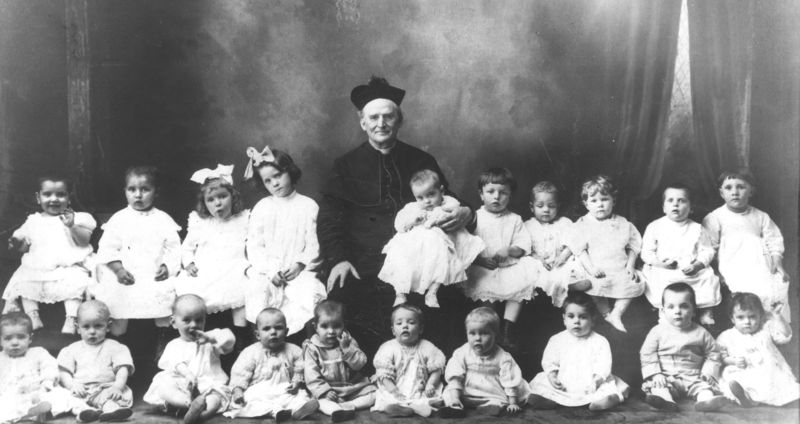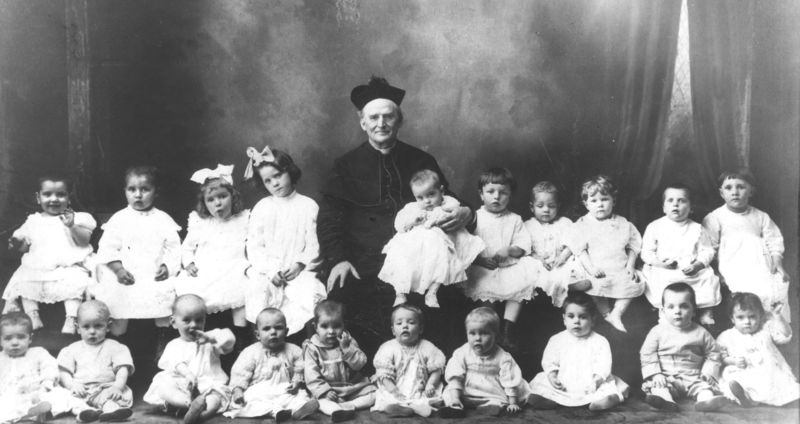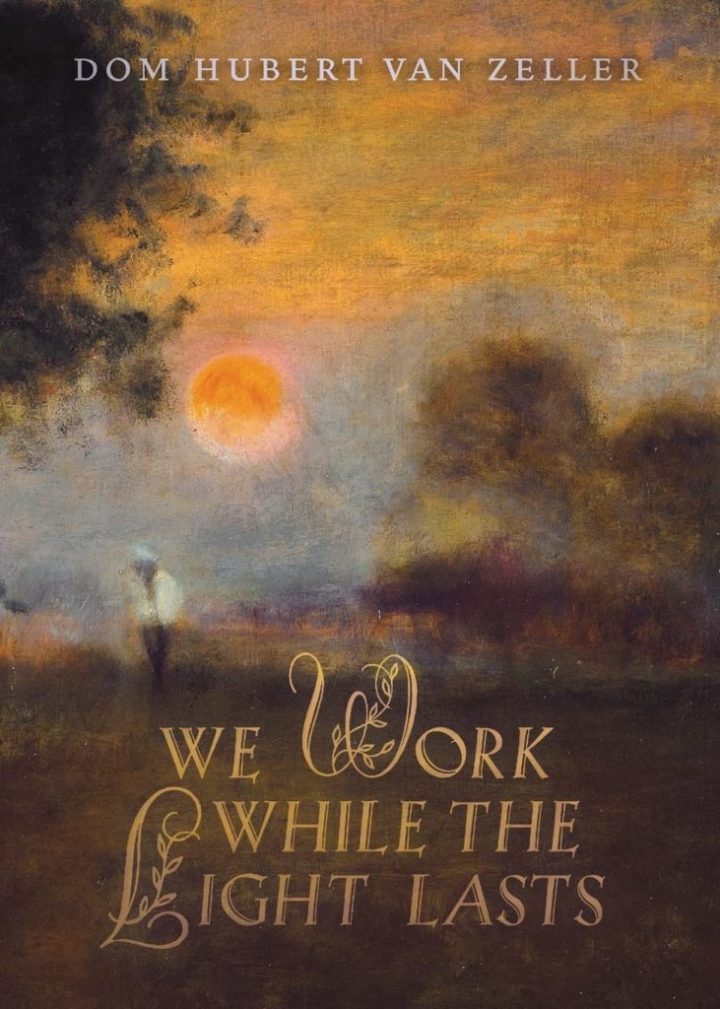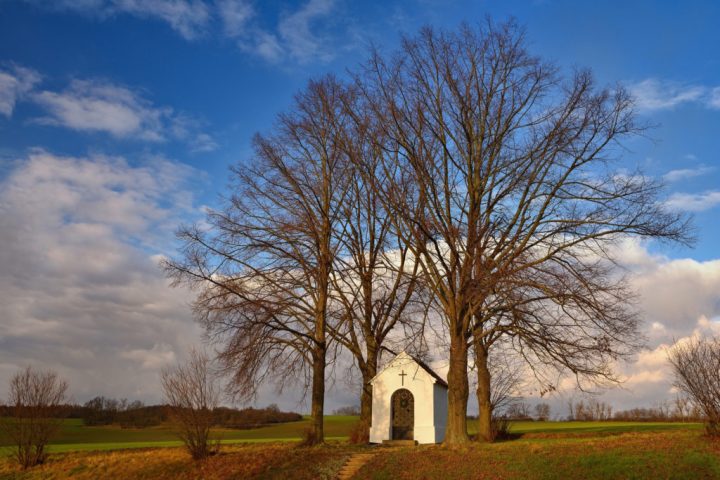
In the city of Lackawanna, New York, near Buffalo, there is an incredibly beautiful basilica dedicated to Our Lady of Victory. This church was built as an act of love and thanksgiving to Jesus and the Blessed Mother by a priest who lived a life of great faith.
Nelson Baker was born on February 16, 1842 in Buffalo, New York to a Catholic mother and a Lutheran father. Nelson and his two brothers were brought up as Lutheran, but when he was nine years old, he was baptized as a Catholic and later received Holy Communion and Confirmation. From a young age, he was devoted to the Blessed Mother. Nelson attended the local public schools and after graduating from high school, he worked for his father in his general store and grocery. He was in the military for a brief time, as a private in the New York State militia for six weeks during the Civil War in 1863; his unit was sent to end the New York draft riots. Afterwards, Nelson and another man started a grain and feed business which became quite successful. Nelson also began volunteering with Father Joseph Hines at St. Joseph’s orphanage. He began to discern a call to the priesthood and received instruction in Latin from a Jesuit priest who was the pastor of St. Michael’s Church in Buffalo. After going on an Ignatian retreat, he asked the Bishop of Buffalo if he could be admitted into the seminary. The following year, in 1869, he went to Our Lady of the Angels Seminary in Niagara, New York.
While in seminary, Nelson became very ill. He developed erysipelas, a skin disease and had to be hospitalized for eleven weeks. In 1874, he learned of an American pilgrimage to Rome led by the Bishop of Fort Wayne, Indiana, and asked his bishop and the rector of the seminary if he could go as an act of thanksgiving for his recovery. They agreed. The pilgrimage began in Paris and it was there that Nelson had an experience that would have a great influence on his life. When visiting the Church of Notre Dame des Victoires, Nelson felt great love for Our Lady under that title and promised to dedicate his life to her service and to promote devotion to her. After two more years of seminary, Nelson Baker was ordained a priest on St. Joseph’s Day, March 19, 1876, at age thirty–four.
Father Baker’s first assignment as a priest was to assist Father Hines at St. Patrick’s Church, St. Joseph’s Orphan Asylum, and Saint John’s Protectory in the Limestone Hill area of West Seneca. (It was later renamed Lackawanna). The institutions were in great debt and as Father Baker did not expect them to remain open, he asked for a new assignment. He was then appointed as a curate in St. Mary’s Parish in Corning, New York for a year. When Father Hines resigned as superintendent in February 1882, Father Baker was appointed the new superintendent of the Institutions and as Pastor of St. Patrick’s Church. His first task was to meet with the creditors and offer partial payment toward the debt – which came from his own savings. However, the Institutions still needed a regular source of funding. One night while praying in church, Father Baker was inspired with the idea of an association dedicated to Our Lady of Victory whose members could financially support the Institutions. He wrote a letter to the post office requesting the names and addresses of Catholic women who might be interested in helping his organization. When he received the list of names, he wrote letters to the women asking them to join the Association of Our Lady of Victory for a small donation of 25 cents per year and to tell their friends about the Association. Members were prayed for in seven novenas of Masses offered at the Institutions and 100 masses at seven European shrines. Members promised to pray the Litany of Our Blessed Lady of Victory every day. Father Baker also started three publications to promote the mission of the Association. Father Baker’s Association is considered one of the first instances of direct mail fundraising.
At this time, there were many homeless children in the United States whose parents had died or who could not afford to take care of them. Different organizations administered orphanages and other charities sent them on “orphan trains” to be adopted by farmers in the Western states. Father Baker was especially concerned that Catholic children be brought up in the Faith. Father Baker was willing to accept any boy in need and boys were sent to him from many other states and Canada. Another problem in this era involved homeless children who were truant or committing crimes. St. John’s Protectory had been founded to help Catholic boys in this situation and provided training in trades for them. Under Father Baker’s leadership, the boys at St. Joseph’s and St. John’s attended Mass every day and were encouraged to receive Holy Communion frequently. The boys also developed devotion to the Blessed Mother In addition to caring for the boys spiritually, the two homes provided an excellent education, and time for recreation each day. The Sisters of St. Joseph of Buffalo and the Brothers of the Holy Infancy and Youth of Jesus assisted Father Baker in caring for and educating the boys in both homes. Father Baker was a true father to the boys. He guided them to be good Catholics, encouraged them, played ball with them, and organized activities for them such as walks in the country, trips to a lake and to Niagara Falls, a summer camp, and an annual picnic in Buffalo. In 1897, he was appointed Director of the Working Boys Home for boys and young men ages 15 and older. In the 1930s, he began a Working Girls Home in Buffalo for unemployed young women.
Father Baker was always thinking of ways he could help the Institutions do more to help children. One idea was to save money on the cost of heat by drilling for natural gas. He believed that gas existed on the property and that Our Lady would help him find it. When he learned that the bishop recently had been given a gift of $5000 for the Diocese, he prayed to the Blessed Mother before asking the bishop for help, and the next day he met with him and requested money to drill a gas well. The bishop gave him $2000 for this project. Father Baker hired workers from Pennsylvania, and on the day they arrived in January 1891, he led a procession with Sisters, Brothers, and altar servers, blessed the field with holy water, placed a statue of Our Lady into the ground, and advised the foreman to drill near the statue. Drilling continued through August, but no gas was found. The bishop supported Father Baker’s efforts, and gave him the remaining $3000 when he requested more money. On the ninth day of Father Baker’s novena to Our Lady, the crew finally located the gas, which provided enough energy for all the Institution’s buildings. Father Baker came up with another idea to provide food for the homes. He established a farm, which raised cattle, pigs, chickens and grew oats, potatoes, and corn.
As he was greatly respected in the Diocese, Father Baker was appointed Vicar General on December 26, 1903 under Bishop Charles Colton, and then re-appointed by the next two bishops. He was named a domestic prelate in 1903 by Pope Pius X, and although given the title “monsignor”, he chose to still be called “Father.”
In addition to his work with Our Lady of Victory Institutions, Father Baker had many responsibilities as a pastor. He started a parish school in 1895 and a high school in 1921, founded two mission parishes with schools, and managed a cemetery. He also helped found D’vouville College in Buffalo and was Vice Chancellor from 1912 through 1935.
Father Baker can be considered one of the saintly patrons of the pro–life movement as he worked to prevent abortions by providing a home for pregnant women and their babies. This ministry began when Father Baker learned that the bodies of over 200 babies were found in a sewer and he realized the necessity of doing something to protect the lives of babies. First, he rented a few rooms in a boarding house, then as more women came for help, he rented the entire building, and after raising money through the Association, he had a house built in 1908 for pregnant young women, babies, and children up to five years old. The privacy of the mothers was very important to him. He kept everything confidential and also had a policy that anyone could leave a baby at the home at any time without filling out paperwork. Babies were sometimes left in a bassinet in the hall by the unlocked front door. Father Baker visited the Infant Home most evenings and blessed the babies and young children. He also started a maternity hospital, which became a general hospital in 1932, and built two homes for the nurses who worked at the hospital and Infant Home.
For many years, Father Baker had dreamed of building a beautiful church to honor Our Lady of Victory, which he hoped would become a national shrine. Finally, in 1921, when he was seventy-nine years old, he began this great project, trusting in God and Our Lady to enable him to complete the church’s construction without owing any debt. Father Baker supervised the entire construction of the church which took five years. The church was completed in December 1925 (without any debt) and the first Mass was celebrated on Christmas day. It was consecrated on May 25, 1926, and designated as a minor basilica on October 3, 1926. It became a place of pilgrimage for Catholics from throughout the United States. Visitors to the basilica today can see a museum dedicated to Father Baker with some of his furniture, vestments, and the little notebooks where he wrote the names of the people who requested his prayers.
Father Baker lived very simply; he wore old clothes and did not spend money on himself. He was ascetic, did not drink alcohol and ate very little. Father Baker put people ahead of work; he always had time for anyone who wanted to talk with him. Father Baker was very generous and would give money to anyone who asked for his help. During the Depression, he helped many people by paying rent for families to stay in their homes, donating clothing, providing shelter, arranging for free medical care, and providing meals. Father Baker had a lot of energy and remained in active ministry until shortly before his death. He began a ministry to African- Americans while in his 90s, with the help of a Redemptorist priest, who once lived at St. Joseph’s as a boy.
A brother who worked closely with Father Baker remembered that he never worried or became discouraged. The source of his strength was his dedication to prayer. He did not attribute any of his ministry’s success to himself but to the Blessed Mother. He said “If we have succeeded in our work, it is because we have had unbounded confidence in God’s Holy Mother, as she has been pleased always to extend to us her generous aid; in our poverty and want, surrounded by every need, when one hardly knew which way to turn, Mary always came to our rescue and opened to us the path of success.”
In 1935, Father Baker’s health declined and he had to spend much of his time resting in his room. He celebrated his 60th anniversary of ordination in March 1936, grateful for his vocation as a priest. In April, he was hospitalized with pneumonia and returned to the hospital in July. On July 17, he received the sacrament of Anointing of the Sick and he died on July 29, 1936 at age 94, of cardiac exhaustion and dilation. Two priests and his doctor were with him when he died and some of the Sisters and Brothers were outside his room praying for him. His funeral was held on August 3, 1936, in the Basilica of Our Lady of Victory and approximately 50,000 people attended it.
In his lifetime and after his death, there have been miracles attributed to Father Baker’s prayers. Many people considered him a saint. In January 1987, the Buffalo Diocese began the cause for Father Baker’s canonization, and on October 7, 1988, he was named a Servant of God. Father Baker was declared Venerable by Pope Benedict XVI on January 14, 2011.
God gave Father Baker many gifts, including the strength to do pastoral and administrative work for a great many people through his early 90s, as well as the great virtues of faith, hope, and love. He is a great example for priests of spiritual fatherhood. His ministries continue today as Our Lady of Victory Homes of Charity.




